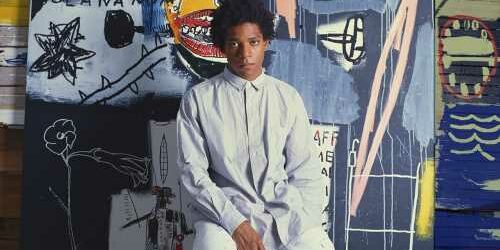Jean-Michel Basquiat was the quintessential New York City artist during his life and after his death. So the arrival of the exhibition Jean-Michel Basquiat: King Pleasure© at the Grand LA in the heart of downtown Los Angeles is a welcome one for those left-coasters who couldn’t catch the display at RXR’s Starrett-Lehigh Building in New York in 2022, where it attracted 210,000 visitors over eight months.
King Pleasure (stylized as King Pleasure©) is presented by Basquiat’s family, with his sisters, Lisane Basquiat and Jeanine Heriveaux guiding and curating the project. This is the first time the artist’s family has opened his estate’s vault, which they have administered since his untimely death in 1988 at the age of 27. Designed by architect David Adjaye with Abbott Miller of Pentagram creating the exhibition’s identity, King Pleasure features over 200 rare and never seen before pieces.
The exhibition is particularly special for admirers of the nonconforming artist as it features a wealth of personal items. These include his birth certificate, report cards, bicycle and artifacts such as his sketchbooks and notes plus other ephemera. King Pleasure also recreates the Basquiat family home with the actual kitchenware, wallpaper and even their ancient thermostat. Amazingly, there are also childhood Super-8 videos of a young Basquiat and his sisters with their parents. More recent videos of his family and friends give a personal perspective on the artist whose legend has grown to astronomical proportions.

Basquiat came to the public’s notice as part of New York’s 1980s pop-art scene, where Keith Haring, Kenny Scharf and Andy Warhol served as elder statesman. Apart from Fred Braithwaite, aka Fab Five Freddy, whose graffiti-writing preceded his musical endeavors, Basquiat was the only artist of color in that scene, and his work reflected his own Black experience experience.
By some accounts, he sold his first painting to Debbie Harry in 1981 for $200. He is also featured as the DJ in the Fab Five Freddy-namechecked “Rapture” video, staring Harry down as she raps in his face. He dated Madonna and created two large-scale murals for the VIP room of Studio 54 founders, Ian Schraeger’s and Steve Rubell’s nightclub, the Palladium. These jaw-dropping murals are on display at King Pleasure in a recreation of that Palladium space.
During his brief career, Basquiat was prolific, arriving on the scene as a fully formed artist with no formal training but an inherent understanding of color and composition. He was successful during his lifetime, often cited as the youngest artist in the many group exhibitions he was part of, as well as his solo ones. His work is among the most sought-after in the world. According to the New York Times, as of 2017, his vibrant skull painting is the sixth-highest sale at auction, commanding $110.5 million. Vogue states that as of 2016, Basquiat was the highest-grossing American artist at auction with $170 million dollars from the sale of 80 works. In the 2004 documentary film “Some Kind of Monster,” Metallica drummer Lars Ulrich sells his 1982 Basquiat painting, “Profit I,” for $5.5 million.
King Pleasure is not an exhibition, or a retrospective of Basquiat’s works — most of which are privately owned. For that, art lovers can cross the street and enjoy The Broad’s stunning collection. Instead, King Pleasure is about his life; his growth; his process. It’s an inside look at the artist’s day-to-day existence, including recreations of his studio, exactly as it was, with untidy stacks of VHS tapes, an ashtray overflowing with cigarette butts, finished and unfinished sketches and his signature Comme des Garçons overcoat. His presence is felt along every step of the expansive display which covers over 15,000 square feet.
Basquiat’s sisters took over the management of his estate since the death of their father in 2013. They had discussed putting on this exhibition as early as 2017. “We wanted to do something different,” says Jeanine, sitting in one of King Pleasure rooms at the Grand LA. “First of all, to show the work we owned that had been sitting in a warehouse. And then, to show the family’s perspective, a narrative that had never been captured. We felt it was important to show why he thought the way he did. The layers, the music we listened to, the TV shows we watched as kids, our house, all the things that impacted the human being he was, we wanted to bring that to life.”

It wasn’t until 2020 that the Basquiat sisters were able to executive produce the exhibition. That factor, coupled with the racial unrest of 2020, made it the right time to begin the curation process. “We wanted to process, and allow other people to process, what was happening in the world from a place of empowerment,” says Lisane, pulling on an official Basquiat jacket. “As a Black man, Jean-Michel claimed his crown [a three-pointed motif symbolic of the artist]. It was a good time to bring his voice more prominently into the conversation. It was also a way for people of color to give voice to that level of competence.”
Until beginning work on King Pleasure, Basquiat had remained somewhat frozen in time for Lisane and Jeanine, who three years and six years his junior, respectively. When they began working on the exhibition, they found themselves immersed in his life. “It was cathartic,” says Lisane.
Basquiat was known to draw on everything, including objects in friends’ homes. One of the famed refrigerator doors he covered with his drawings is on display, as are the fences he painted when living in the Venice area of Los Angeles, as well as the facade of his studio there. While Basquiat is firmly associated with New York, he spent a significant amount of time in Los Angeles and had multiple exhibitions in the city.
A map of Los Angeles shows Basquiat’s frequent haunts, including the famed Mr. Chow restaurant in Beverly Hills, L’Hermitage Hotel, Maxfield, Tower Records, Chateau Marmont and Power Tools, one of the city’s legendary nightclubs run by Jon Sidel and the late Matt Dike. Dike worked as Basquiat’s studio assistant and went on to co-found Delicious Vinyl and co-produce the Beastie Boys’ landmark 1989 album “Paul’s Boutique.” His home was among those Basquiat adorned with many drawings.
Spotify has curated an official playlist to accompany the exhibition titled Listen Like Basquiat: Nightlife. It features more than three hours of music that is representative of what the artist listened to during his most public years. It’s culled from over six hours’ worth of music handpicked by his sisters. The excellent choices run the gamut from David Bowie and Madonna to Rockwell, Blondie, Grace Jones, Grandmaster Flash, Donna Summer and Run-D.M.C.
From accounts and images of the time, Basquiat was a man about town, frequenting clubs and attending parties every night. But his work was, and is, a bold commentary on the range of injustices he witnessed and experienced firsthand, not the least of which were racial. His work speaks volumes about his negative experiences, in particular his unsettling painting “Jailbirds,” which is part of King Pleasure.
“There is a lot of Jean-Michel’s influence on artists that came after him,” says Lisane. “He gave artists permission to fully express themselves and courageously say what they had to say through their art. If Jean-Michel saw something, he spoke about it. He wasn’t as focused on the end game as he was on ensuring that he was a clear channel to his creative voice. I think people are drawn to how unedited his creativity was.”

What is not included in the exhibition is Basquiat’s experience with abuse — allegations of physical abuse at the hands of his parents, which he spoke of often, and of the substances kind, which ultimately killed him. The Basquiat sisters have been accused of putting on a hagiography that idealizes its subject rather than giving a complete picture of his life.
To this assertion, Jeanine responds: “What’s wrong with that? Everyone wants drama and a hot mess. We choose to celebrate Jean-Michel’s life. This show is from our perspective. We make no apologies about that.”
Lisane adds, “This is a love letter to our brother, to our parents, and to our legacy. We are a first-generation family that grew up in Brooklyn. We are two of three children. Our brother died. What we address in this exhibition is that Jean-Michel came from a family. When someone passes away in their 20s, when a family is fractured, they then have figure out how to navigate that situation and how to move forward.”

The sisters have also been been accused of commodifying Basquiat’s legacy in a cash-grab. The King Pleasure Emporium has everything from hoodies and T-shirts to jigsaw puzzles, skate decks, tumblers, magnets and a fantastic comprehensive catalog written by the Basquiat sisters. There is a collaboration with Coach and one with Bearbricks.
“We’ve also heard the flip side: you can’t buy a painting or a drawing, but you can buy a T-shirt or a plate that allows you to have access to Jean-Michel’s work,” says Lisane. “As a family, we have honored and respected the value of our brother’s work and legacy. We have held it in the utmost esteem.”
The fact is, maintaining the Basquiat estate is costly. It doesn’t generate income unless you sell the pieces. Basquiat’s father had to do just that to pay off his son’s outstanding tax debts upon his death. The elder Basquiat is largely responsible for the value his son’s work has, due to the diligence with which he authenticated his work.
“If we were in this for the money, we would have sold everything and lived very well,” Jeanine states.
As for what they hope visitors to King Pleasure will come away with, Jeanine says, “New things they didn’t know about Jean-Michel. Courage to be themselves and inspiration by what he left behind.”
Read More About:
Source: Read Full Article


